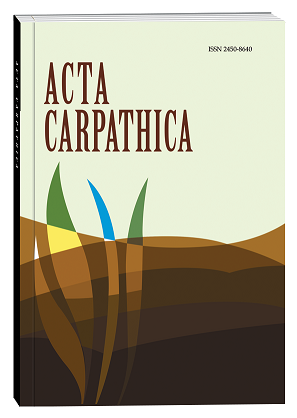THE INFLUENCE OF METHODS OF EXTRACTING ON THE ANTIOXIDANT ACTIVITY OF THE EXTRACTS OF THE HERB OF PLANTS HYSSOPUS OFFICINALIS L. AND MELISSA OFFICINALIS L.
DOI:
https://doi.org/10.32782/2450-8640.2022.2.1Keywords:
extracting, antioxidant activity, medicinal plant raw material, Hyssopus officinalis L., Melissa officinalis L.Abstract
The article considers the issue of the search of medicinal plants with higher content of antioxidants and working out the methods of their maximal withdrawal into extracts. It deals with the analysis of the influence of different factors on the dynamics of process of extracting of medicinal plant raw material, in particular, its kind, chemical nature, degree of grinding, ratio of raw material and extractant, nature of extractant, duration and temperature of extracting. We have investigated the integral antioxidant activity (AOA) of alcohol and obtained with the help of three methods extracting of aqueous extracts of the herb of medicinal hyssop (Hyssopus officinalis L.) and lemon balm (Melissa officinalis L.), gathered on the educational and research plot of Drohobych Ivan Franko State Pedagogical University. One determined AOA of the extracts by potentiometric method with the help of mediating system. We have ascertained, that alcohol extracts of the investigated substance of the medicinal plant raw material detect AOA 1,2–1,8 times higher compared to the aqueous ones, obtained by different methods. The indices of AOA for the alcohol extracts of the herb of plants H. officinalis and M. officinalis respectively are 2,66 ± 0,08 mg AA/ml and 2,94 ± 0,17 mg AA/ml. We have shown, that best way of aqueous extracting of both the herb H. officinalis and M. officinalis is the second one, at which one the plant raw material was poured on with hot water (70 °С), infused during 15 min. on boiling water steam and condensed 45 min. The AOA of the obtained with one of those methods of aqueous extract H. officinalis is 1,93 ± 0,1 mg AA/ml. This index is by 31,3% higher from AOA of the extract, obtained by the third method, and by 18,4% – by the first one. All the extracts of M. officinalis detect higher AOA compared to the H. officinalis. In case of the second method of aqueous extraction of AOA extracts of M. officinalis makes 2,45 ± 0,11 mg AA/ml, that is by 16,7% higher, compared to the third method and by 17,2% – from extracting by the first method.
References
Антиоксидантні властивості деяких видів рослинної сировини / М. Головко та ін. Східно-Європейський журнал передових технологій. 2011. T. 4. № 6 (52). С. 9–11.
Гончарук Є., Коршун М. Вільнорадикальне окиснення як універсальний неспецифічний механізм пошкоджуючої дії шкідливих чинників довкілля (огляд літератури та власних досліджень). Журнал Академії медичних наук України. 2004. Т. 10. № 1. С. 131–150.
Гиріна О., Глущенко А. Перебіг вільнорадикальних процесів і підбір антиоксидантної терапії при ішемічній хворобі серця. Ліки України. 2003. № 4. С. 13–19.
Антиоксидантна система захисту організму: огляд / І. Бєленічев та ін. Сучасні проблеми токсикології. 2002. № 3. С. 5–17.
Dillard C.J., German J.B. Phytochemicals: nutraceuticals and human health. J. Sci. Food Agric. 2000. Vol. 80. P. 1744–1756.
Antioxidant and prooxidant properties of flavonoids / D. Prochazkova et al. Fitoterapia. 2011. Vol. 82. Iss. 4. P. 513–523. DOI: 10.1016/j.fitote.2011.01.018.
Modern extraction methods for preparation of bioactive plant extracts / A. Gupta et al. International J. of Applied and Natural Sciences. 2012. Vol. 1. Iss. 1. P. 8–26.
Дослідження параметрів екстракції трави приворотня / А. Грицик та ін. Modern Pharmacy and Medicine. 2021. Vol. 1. Iss. 2. P. 1–9.
Дослідження технологічних характеристик квіток календули (Flores Calendulae) для оптимізації екстракції флавоноїдів / О. Протункевич та ін. Південноукраїнський медичний науковий журнал. 2019. № 24. С. 56–60.
Бандура В., Коляновська Л. Аналіз сучасних методів та факторів, що впливають на процес екстрагування. Збірник наукових праць Вінницького національного аграрного університету. Серія «Технічні науки». 2014. № 2 (85). С. 130–135.
Державна Фармакопея України : у 3 т. 2-е вид. Харків : Державне підприємство «Український науковий фармакопейний центр якості лікарських засобів», 2015. Т. 1. 1128 с.
Потенціометричне визначення антиоксидантної активності екстрактів рослин Calendula officinalis L. за впливу біостимуляторів росту / О. Лупак та ін. Scientific Jornal “Science Rise: Biological Science”. 2017. № 6 (9). С. 10–13.
Potentiometric Study of Antioxidant Activity: Development and Prospects / A. Ivanova et al. Critical Reviews in Analytical Chemistry. 2015. Vol. 45. Iss. 4. P. 311–322.
Исследование антиоксидантной активности растительности Ферганской долины / Д. Аронбаев и др. Молодой учëный. 2015. № 4 (84). С. 30–34.
Котюк Л. Особливості мікроморфологічної будови гісопу лікарського. Modern Phytomorphology. 2016. Vol. 10. P. 59–67.
Шпичак О. Ідентифікація трави меліси, шишок хмелю та суцвіть лаванди у сумішах з рослинної сировини методом тонкошарової хроматографії. Вісник фармації. 2012. № 1 (69). С. 57–60.
Дослідження кислот гідроксикоричних трави чистецю Зібольда / С. Марчишин та ін. Медична та клінічна хімія. 2016. Т. 18. № 3. С. 13–16.








